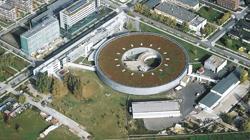Hahn-Meitner Institute and Bessy combine forces in nanomaterials and solar research
Two large radiation research centres in Berlin have finally received a green light from state and federal officials to merge, a move that German Research Minister Annette Schavan said will make Berlin a world-class interdisciplinary centre for nanomaterials and solar energy research.
The Hahn-Meitner Institute (HMI), which focuses on solar energy and structural research by using neutron beams as probes, will merge in January 2009 with the smaller Bessy (Berlin Electron Storage Ring for Synchrotron Radiation) facility, which can deliver ultra-bright photon beams from long-wave terahertz waves right through to hard x-rays. Leaders of the two research centres say that the two radiation sources - neutron and photon - ’complement each other perfectly’ and it makes scientific sense to combine the two centres.

Bessy, with about a 230 staff and now part of the Leibniz Association research network, will after the merger come under the umbrella of the Helmholtz Association of research centres, of which HMI, with about 800 staff, already is a member.
Kirstin Plonkai a spokeswoman at HMI, told Chemistry World that about 20 chemists are involved in research, with a big role in electrochemistry. The two other major disciplines represented at HMI are physics and engineering.
Schavan, announcing the merger this week, said the new combined centre will operate with an annual budget of €100 million and will be comparable to the European Synchrotron Radiation Facility in Grenoble, France, the Rutherford Labs in the UK and the Paul Scherrer Institute in Switzerland.
A particular focus of the combined centre will be magnetic materials, with a new €17.8 million high field magnet, which she described as ’world’s strongest’, now under construction and expected to be operational by 2011.
Ned Stafford






No comments yet